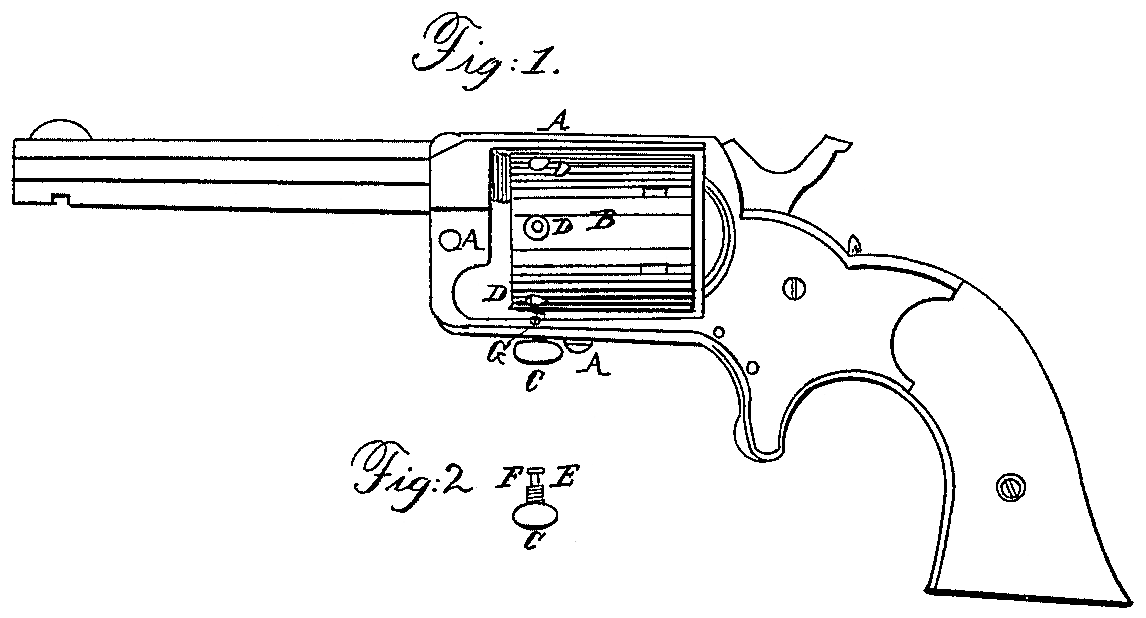US 44126
UNITED STATES PATENT OFFICE.
WM. TILESTON, OF GEORGETOWN, DISTRICT OF COLUMBIA.
IMPROVEMENT IN SAFETY-STOPS FOR REVOLVING FIRE-ARMS.
Specification forming part of Letters Patent No. 44,126, dated September 6, 1864.
To all whom it may concern:
Be it known that I, William Tileston, of Georgetown, in the county of Washington, in the District of Columbia, have invented a new and useful Improvement in Fire-Arms; and I do hereby declare that the following is a full and exact description of its construction and operation.
Figure I is a view of a revolving fire-arm with the screw.lock attached. Fig. II is a view of the screw-lock detached from the fire-arm.
The object of my invention is to construct a lock for revolving fire-arms to prevent the cylinders thereof from revolving when not in immediate use, and also to prevent the point of the hammer from resting on the cartridge-head or on the caps when the gun is loaded, and thus effectually preventing the accidental discharge of the fire-arm by falling or by having the hammer struck while resting on the cartridge-head or on the cap. To accomplish this object I take any revolving fire-arm and through the lower part of the frame A A, Fig. I, which supports the cylinder B, a hole is made at right angles with the cylinder, in which a thread is cut. At right angles with this hole, into the side of the frame, another hole is made, which communicates with the first-named hole, and in which a thread is also cut.
In the hole at right angles with the cylinder the screw-lock C, Figs. I and II, is inserted, which may be screwed in so that the inner end thereof will enter one of the countersinks or depressions D D D in the cylinder.
The screw-lock is made in the form of a thumb-screw, or in any other form that will enable it to be turned easily with the thumb and fingers, and is made with a neck, E, and a shoulder, F, as shown in Fig. II.
In the hole in the frame, running at right angles and communicating with the hole in which the screw-lock is placed, a stop-screw, G, Fig. I, is inserted, the point of which extends to the neck E on the screw-lock, and by means of the shoulder F prevents the screw lock from being unscrewed a sufficient distance to become detached or to fall out of the frame, but a sufficient distance to be free from the cylinder, allowing it to revolve freely when required.
The countersinks or depressions D D D in the cylinder, in which the point of the screw-lock enters, are placed in such a position that when the cylinder is locked the point of the hammer, when down, will rest on the cylinder between the chambers.
The screw-lock may be placed on a different part of the fire-arm, if convenient, and lock the cylinder by means of countersinks or depressions in a different part of it.
The operation of the screw-lock is as follows: Place the hammer at a half-cock. Turn the cylinder so that one of the countersinks or depressions will be directly opposite the point of the screw-lock. Turn the screw-lock to the right until the point thereof enters the countersink, which will lock the cylinder. To unlock the cylinder, turn the screw-lock to the left until the shoulder strikes the stop screw.
It is of very great importance to have revolving fire-arms, when loaded, so arranged that they cannot be accidentally discharged, which frequently occurs in the ordinary manner of constructing them, and by which many lives have been lost. My screw-lock will effectually prevent this and render it safe for any person of ordinary intellect to carry the fire-arm with out fear or danger of it being accidentally discharged, and its construction is so simple that a child a few years old can comprehend and operate it.
What I claim as my invention, and desire to secure by Letters Patent, is—
The screw-lock C, the stop-screw G, and the countersinks or depressions D D D, constructed and used substantially as and for the purpose set forth.
WM. TILESTON.
Witnesses:
Jno. H. Duine,
Benj. F. Titlow.

